Amalie Robert Estate: 2018 Spring Cellar Report
Hello and Welcome,
This is the 2018 Spring Cellar Report from Amalie Robert Estate. A FLOG communication.
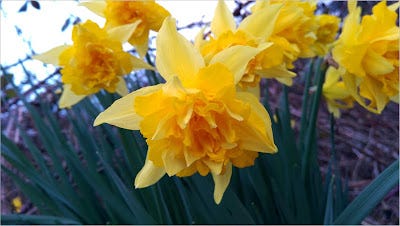
There are all sorts of clichés, but in the wine industry we are always looking for our niche. In fact, a niche cliché is what we are looking for today.
At the end of harvesting 100 tons of wine berries over the course of 7 weeks, we were “As delighted as the dog that actually caught the car.” And since we farm on hillsides, we would remind everyone that “..it doesn’t run uphill.” But after turning 100 tons of wine berries into about 16,500 gallons of wine, we are leaning-in “Like trying to get a drink out of a fire hose.”


But now that Spring is beginning to emerge, we are onto the next big thing – Blending for Complexity.
We turn back a vintage and begin our quest for the Hers and His reserves. You see we “barrel over”. That is in fact different from “being over a barrel” which seems to be a Hollywood thing.
To “barrel over” means to hold your wine in barrel over the next vintage. At Amalie Robert Estate our Pinot Noir and Syrah are in barrel while the next vintage is coming into the winery. At the end of the day, we are looking to have our Pinot Noir in barrel for around 18 months and our Syrah for closer to 26 months. And yes that requires us to have twice as many barrels, and a place to age them, than wineries that empty their barrels after 11 months so they can refill them with the next vintage.

And there is more than one way around the barn, or through the cellar. There is always a fast way, a wrong way, and the Ernie way. Other than increasing costs, the Ernie way has the added benefit of extended barrel maturation. This allows our whole cluster tannin to soften naturally over time. There is no need to add fining agents that modify the aroma, flavor, taste or texture of our wines. You are getting the real deal from Amalie Robert - time in a bottle. Or think if it as a message in a bottle.
The other way to do it is to add something that will soften the whole cluster astringency and advance the wine’s maturity window. Historically, egg whites and ox blood were used. This continued until winemakers realized that chicken eggs were a lot more economical than other additives. However, fish bladders are still in use for white wines to this day. Hey Google, “What is isinglass?”
By the time we get to blending, our Amalie’s Cuvée (Hers) and Estate Selection (His) Pinot Noir wines have been in the same barrel they were filled into for about a year. No racking from barrel to barrel allowed. The yeast lees that came down from the press with the wine are now settled in the bottom of the barrel. And since our barrels are on their side, the bottom of the barrel is called the bilge. Directly opposite the bilge is the bung. This is how you know the barrel is in the correct wine maturation position.

Our job is to select about 20 or so barrels of wine that contain our favorite wine from the vintage. Since we harvest, ferment and then fill barrels from each of our 42 blocks separately, we have the ability to taste the wines grown from each and every one of our vineyard blocks. This allows us the ultimate flexibility in creating our Hers and His reserve blends. But be careful what you ask for, as that adds up to about 200 and some barrels per year. You can’t boil the ocean.

What we can do is critically evaluate about 10 barrels of wine per session. This is usually an afternoon thing. And we seem to be predisposed to Friday afternoons. It’s just our thing. Oh sure, we can taste wine from more than 10 barrels in an afternoon – no problem there! However, the problem comes the next day when you are trying to decipher the notes of barrel number 16 - what language is that? That is why 10 is the magic number, at 4 pm, on a Friday afternoon.
Some people will take a more technical approach and begin evaluations in the late morning or early afternoon. And that is all well and good. But we blend our wines with an eye toward enjoying them with a meal and with friends. We start to get a little wine craving in the afternoon and feel this is the better time for us to critically evaluate wines. Of course, your mileage may vary.
Once we make the first pass through the cellar, we can usually get our favorites list down to about 20 or so barrels and that is a good place to start. The magic number for the Hers and His Reserves is 12 barrels each, about 300 cases worth. Logistically, this is three of our blending tanks, so even though the 13 barrel blend is good, there is nowhere to put it.
Now comes the hard part, finding which of those 20 barrels of wine are going to make the final cut to get us down to 12. There are plenty of algorithms to use to sort them. From our Computer Science days, we could use a bubble sort, a merge sort or a quick sort. Or we could actually taste them and rank the aroma, flavor, texture and finish. Hopefully this illustrates one of the reasons we left the hi-tech world for wine.
Once all of our barrel samples are ranked on their criteria, we begin blending a few samples together. The joy is when the barrels combine to build enhanced aroma, flavor, texture and finish. We can adjust the blend naturally by including a sample that is more high toned, or contributes more structure. If the finish is too astringent, we can swap out a barrel for something softer. We call this blending for complexity. It does take discipline, attention to detail and several iterations. Another benefit of our approach, is that we do not have to add aforementioned fining agents to modify our wines. We just look to swap a barrel that helps to temper the blend.
And that is how we get from 20 individually stunning barrels of wine, to a blend of 12 that combine into a wine that is as sublime as the day is long. Of course, Dena has veto power. If the blend doesn’t feel just right, then it’s back to the blending bench. Often times this is in the kitchen, which is handy when we are evaluating the blend for its culinary suitability.
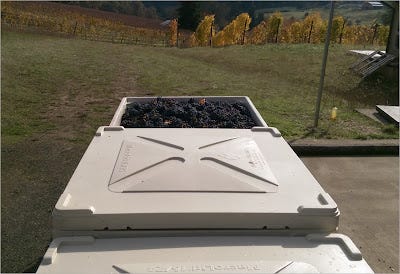
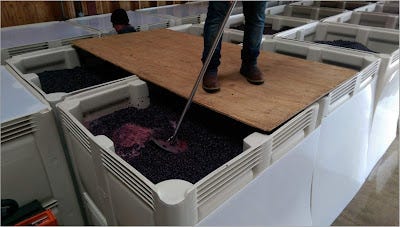
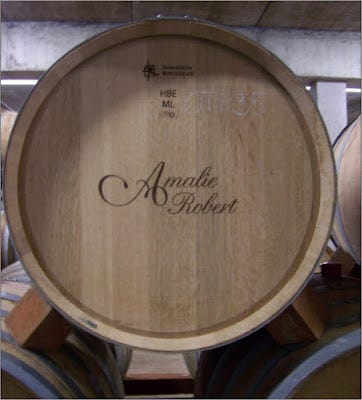
And let’s spend a minute on the Farmer barrel. As each vineyard block is harvested, fermented and sent to barrel separately, we can get a read on how Ernie managed the vineyard. And that is where the Farmer barrel comes into focus. We are not giving away any trade secrets here by telling you that each fermenter fills about 4 barrels. The first barrel is brand new each year. The next two barrels have been filled two or three times. And then there is the fourth barrel, the Farmer barrel.
The Farmer barrel is always dead neutral. That means that if it did not come over to the New World on the Mayflower, then it has been filled (and by definition emptied) several times. The result is that there is no oak influence left in the barrel. This barrel, the Farmer barrel, is where we can evaluate how the fruit from the vineyard is showing without any oak influence whatsoever.
This feedback is quite useful to the Ernie who farms our field. He can dial in his vineyard management program of leaf pull, cover crops, hedging, vineyard floor management, thinning and harvest strategy to modify the aroma, flavor, texture and finish of our wines.
Spoiler Alert: All of those aroma, flavor, texture and finish characteristics in the finished wine are a natural evolution from not only the terroir, but also the human factor of what was or was not done as a response to the vintage. And all of our vineyard management techniques and viticultural practices are site specific to Amalie Robert Estate as we farm our own field, and no one else’s. Good to know.
The feedback loop is YUUGE when it comes to our stainless steel fermented whites such as Her Silhouette Chardonnay and Our Muse Viognier. Stainless steel fermented white wines are the most transparent exemplars of terroir you will find. And the GWZ’R Gewürztraminer is coming, so please be patient. It takes a while to build up to critical mass with just 24 vines.

The making of iPinot. So, after the Hers and His, we have a few barrels that are quite pleasurable, but “didn’t make the team” Hers or His. What to do? Ah yes, these reserve level barrels, when blended among themselves make quite a compelling wine from the vintage.
iPinot and the three halves of Pinot Noir. People will tell you there are only two halves to Pinot Noir. It doesn’t have to be that way. Let us explain. The first half of Pinot Noir is the brilliantly elegant color refracting with a simple twist of the wrist releasing a heady bouquet – Very nice indeed.
The second half of Pinot Noir is when it colonizes your palate. Lively, delineated, lithe and tart, supple and sweet - all the things that stunning Pinot Noirs are made from. And then comes the third half of Pinot Noir – the scintillating and enduring finish of refined whole cluster stem tannin.
Fermenting with whole clusters extracts a little tannin from the stems. If you want to experience this for yourself, purchase some table grapes, remove the fruit and chew on the stems. Do it in front of the mirror for the full effect. Wowza!
However, over time, oxygen makes its way to the wine and gently softens this astringency into refined tannins. These refined tannins manifest themselves as a silky mouthfeel contributing length and a more than just subtle grip to the finish. That is the third half of Pinot Noir.
For all of you analytical types out there, try this exercise. Everyone knows that 50 is half of 100. And most people will tell you there are only two halves to a whole. But are there not three 50's in 100? Sure there are: 0 – 50 is a 50; 25 – 75 is a 50; and then there is 50 – 100, the third half! That makes three halves to a whole. Who’s got change for a $100?
iPinot is sold direct from the winery. If some day Apple is looking to acquire a winery, well let’s just say we trademarked iPinot with an eye toward the future.
Now it would not be a FLOG communication from Amalie Robert Estate if we didn’t do the numbers. Let’s see here, how about 94? That’s as good a number as any. It also just happens to be the review Ernie’s 2012 Top Barrel Syrah earned from Vinous in early February 2018. Not only is this the highest score ever for an estate grown Willamette Valley Syrah, it is the first 94. And that is the thing about being the first one, no matter who follows, you are always the first one!
Let's review, shall we:

The stainless steel fermented white wines are a window into our terroir. 2016 Her Silhouette Chardonnay is our Chablis style, stainless steel fermented Chardonnay where we block the malo-lactic conversion.
“Brilliant straw-yellow. High-pitched Meyer lemon and green apple aromas are complemented by suave jasmine and zesty mineral notes. Tangy and focused on the palate, offering bitter citrus zest and pear skin flavors that pick up a gingery accent with air. Shows a hint of fennel on the finish, which lingers with strong, subtly sweet tenacity. 91.” - Vinous, February 8, 2018

2016 Our Muse Viognier is stainless steel fermented Viognier. This is part of Ernie’s Northern Rhône program. The 2016 vintage earns a 93 point review and an “Editors’ Choice” from Wine Enthusiast on April 1, 2018. (Tomorrow’s news today!)
“Pale green-tinged yellow. Bright and precise on the nose, displaying fresh white peach, tangerine and pungent floral qualities along with delicate honey and white pepper flourishes. Juicy, focused on light on its feet, offering juicy orchard and pit fruit flavors that are given tangy cut by an orange zest nuance. Finishes silky and long, featuring lingering florality and a hint of candied citrus fruits. 91.” - Vinous, February 8, 2018
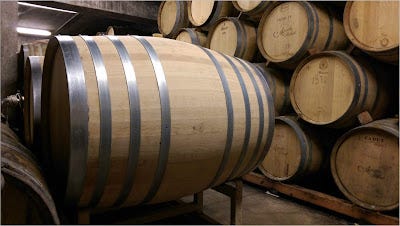
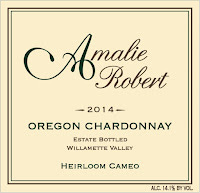
The 2014 Heirloom Cameo Chardonnay is our BFC (Barrel Fermented Chardonnay.) Fermented in a new 500-liter puncheon each year, this is our answer to White Burgundy, Chassagne-Montrachet in particular.
“Limpid yellow. Ripe pear, Meyer lemon, vanilla and smoky minerals on the deeply perfumed nose, along with hints of jasmine and candied ginger that build in the background. Supple and well-concentrated, offering expansive citrus and orchard fruit flavors complemented by brioche and toasty lees nuances. The floral note repeats emphatically on the very long, supple finish, which is energized by a jolt of zesty acidity. 92.” - Vinous, February 8, 2018
Rosé is the newest category in the Amalie Robert Estate portfolio and we have doubled down. Our original Rosé of Pinot Noir is called Pinot in Pink Rosé. Fermented in stainless steel with vivacious acidity to “crush it” on the lanai, or veranda, or even the back patio. Yes, it’s really that versatile.
“Lurid orange-pink. Mineral-accented red berries, citrus fruits and rose pastille on the expressive, sharply focused nose. Juicy and precise on the palate, offering concentrated raspberry and tangerine flavors that show excellent clarity and spicy lift. Powerful yet lithe, delivering strong closing thrust and a lingering suggestion of candied flowers. 91.” - Vinous, February 8, 2018

Our latest effort, 2016 Bellpine Pearl Rosé is where you end up if you are thinking about making a base wine for sparkling wine. This wine is made from the wings of Pinot Meunier and Pinot Noir. In the weeks leading up to harvest, Ernie has the crew thin the wings from the main clusters. After a gentle pass through the press the juice picks up a little color and then is fermented in stainless steel.
“Full orange. Dried red berries, orange pith and pungent flowers on the mineral-accented nose. Concentrated red berry and citrus fruit flavors are accompanied by a spicy element that adds back-end lift and cut. Rich yet lively, delivering solid closing thrust on a long, supple finish that echoes the berry note. 90.” - Vinous, February 8, 2018
The ALT-Reds:
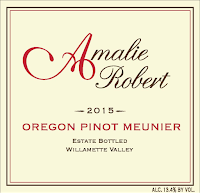
And there is good news for all of you Pinot Meunier fans out there! The 2015 vintage earns another 91 point review from Vinous. The pinnacle for us was the 2014 vintage. Last year the 2014 Pinot Meunier earned the highest rating of any Pinot Meunier from Oregon with a 92. They say it is a fine line between genius and insanity. What a difference a point makes. While the 2015 vintage has “left the building,” the 2016 Pinot Meunier is released and ready to go!
2015 vintage: “Brilliant red. Spice- and herb-tinged cherry and red currant scents, slowly joined by subtle woodsmoke and cola notes. Chewy and focused on entry, offering bitter cherry and rose pastille flavors that flesh out and become sweeter with air. Nicely concentrated but lively as well, showing strong closing thrust, dusty tannins and a lingering cherry note. 91.” - Vinous, February 8, 2018
And that brings us to the Syrah program at Amalie Robert Estate, aka Côte Rôtie from Oregon. Lucky Block 13 has 4 clones of Syrah all sourced from the cool Northern Rhône growing region called Côte Rôtie. Côte Rôtie is often referred to as the “Burgundy of the Rhone.” Hmm, sounds intriguing.

Due to a lack of focus and attention to detail during the grafting process, we have a few Viognier plants interspersed in Lucky Block 13. Sauce for the goose, as they say. Ernie said something quite different the first year he saw the Viognier grapes in his Syrah block. Nonetheless, he took it all in stride and chose not to dig them out. Besides, after three years, they had put down some serious roots. Farmer first, winemaker second, aka Winegrower.
While we harvest, ferment and barrel all of our 30 plus acres of Pinot Noir by block, Ernie drills down to the next level with Syrah. He harvests each row of Syrah separately. This is the only way he can maintain the clonal integrity of the block. Dena just smiles and remembers when they first met. “Yeah, Ernie is wired a little differently.”
About half of all the Syrah berries go in the fermenter on the stem as whole clusters. That’s a lot of astringency in a young wine, and it is going to take a while to unwind, but Ernie loves the tactile structure you can only get from whole cluster fermentation. No matter, these wines are built to slowly unwind over time. And that process starts with about 26 months of barrel maturation encased within 1,200 tons of concrete below grade in the cellar at Amalie Robert Estate.
After that amount of time things have mellowed out, a bit. Then it is time to see just what has evolved over the past couple of years. This is when we find out if we have a “Top Barrel” candidate from the vintage. If so, that single barrel is bottled separately as the Top Barrel Syrah and the remaining barrels are blended to create our Satisfaction Syrah.
2011 vintage Top Barrel Syrah: “In a thrilling cool-climate experiment, the team at Amalie Robert planted syrah and viognier on a single acre in a cool vineyard west of Salem, drawing from the four clones that Marcel Guigal recommended on a visit to Oregon. This wine barely crosses the threshold of 12 per cent alcohol, and in most respects would be thought of as backward. But the aromas - carob, smoke and olive - are resolved and mature, the flavors composed and quiet, dark red fruits marked by charry, mature tannins. Decant it to serve with lamb. 91.” - Year's Best US Syrahs, Patrick J. Comiskey, Wine & Spirits Magazine, February 2018
Included in the recent “Oregon’s Expanding Palette of Wines” from Vinous, February 8, 2018, is a little note about our Syrah program.
“Amalie Robert, whose vineyard is in the western part of the Willamette Valley, makes a very strong case for Syrah, but production of their two graceful wines is painfully small, as in just a few barrels of wine per vintage.”

2012 vintage Top Barrel Syrah: “Brilliant violet. A complex, expansive bouquet evokes ripe black and blue fruits, smoky Indian spices and potpourri, backed by subtle olive and cola nuances. Sweet, sappy and penetrating on the palate, offering intense blueberry, cassis, bitter chocolate and spicecake flavors and a strong suggestion of candied violet. Strongly channels the savory qualities of the northern Rhône and finishes extremely long, smooth and spicy, with subtle tannins building slowly. 94.” - Vinous, February 8, 2018
Please note, the 2012 Top Barrel is the highest rated Syrah from the Willamette Valley and the first to earn a 94 point review from Vinous. So for now, the Top Barrel reigns supreme.
2013 vintage Top Barrel Syrah: “Lurid ruby. Pungent, spice-tinged boysenberry, cherry pit and licorice scents are complemented by suggestions of cracked pepper, violet and woodsmoke. Juicy and focused on the palate, offering bitter cherry and dark berry flavors that unfold slowly on the back half. Decidedly lithe, even Pinot-esque compared to its 2012 sibling, featuring good tension and spicy cut on the very long, gently tannic finish. 92.” - Vinous, February 8, 2018
Ah yes, a Syrah with a Pinot-esque finish. That's how you know your Syrah was made by a Pinot guy. Not to be confused with Pinot made by a Syrah guy. For those of you who demand Satisfaction, here it is!
2011 vintage Satisfaction Syrah: “The 2011 Syrah Satisfaction includes 50% whole-cluster fruit of four Rhône clones (plus a touch of co-planté Viognier vines). Not picked until November 14, it has an attractive bouquet with macerated red cherries, Provençal herbs, juniper berries and a touch of melted wax. The palate is medium bodied with ripe red berry fruit mixed with blueberry, Seville orange marmalade and a healthy pinch of white pepper lending the finish that Rhône “vibe.” Very linear at the moment, the finish is quite tight. I would actually cellar this for one or two years as it should replay handsomely. 91.” - The Wine Advocate, March 2015
2012 vintage Satisfaction Syrah: “Vivid ruby. Heady spice- and mineral-accented raspberry and cherry scents show excellent clarity and pick up subtle woodsmoke and cola nuances as the wine opens up. Alluringly sweet and precise on the palate offering intense red fruit liqueur blood orange spicecake and violet pastille flavors that show a suave blend of richness of vivacity and no rough edges that I can detect. Finishes very long sappy and smooth with fine-grained tannins lending gentle grip. 92.”- Vinous, January 2017

2013 vintage Satisfaction Syrah: “Bright ruby. Fresh cherry and dark berries on the nose, along with hints of incense, olive paste and candied flowers. Energetic and focused in style, offering bitter cherry and cassis flavors and spicy touch of cracked pepper that appears on the back half. Finishes very long and precise, displaying repeating spiciness and dusty tannins that lend gentle grip. 90.” - Vinous, February 8, 2018

And that about wraps it up for the Spring Cellar Report. The Monthly FLOGs will start up again with the April update where we expect an early bud break, despite the late snow fall. That’s Mother Nature's sense of humor for you, what a kick in the pants! As farmers, we have learned it makes a difference which way you stand.
We realize that our communications are a tad bit longer than most that come across your inbox. Kind of like shoving 10 pounds of it in a 5 pound bag. Or as Ernie would tell you, that’s how we get three halves into our Pinot Noirs.
Kindest Regards,
Dena & Ernie



